Mr. Lincoln Sits for His Portrait: The Story of a Photograph That Became an American Icon by Leonard S. Marcus, Farrar Straus Giroux, 2023; You Can’t Say That! Writers for Young People Talk About Censorship, Free Expression, and the Stories They Have to Tell by Leonard S. Marcus, Candlewick Press, 2021.
This month’s post brings you two books by the acclaimed expert on children’s books and author of numerous award-winning biographies, Leonard S. Marcus. You Can’t Say That! delves into the timely topic of censorship of books for young people with interviews of thirteen children’s book creators reflecting on their experiences. Mr. Lincoln Sits for His Portrait, written for middle graders and up, is a fresh biography of Abraham Lincoln that examines his love of the technology of his time–especially photography–and the making of an iconic image of the beloved President and his 10-year-old son Tad.
“Every photograph has a point of view, revealing some facets of its subject and missing or glossing over others. The strongest photographs possess the power to crowd out competing points of view and become the version of reality that people remember.”
~ Leonard S. Marcus
Why these books? Why will they matter to kids?
For a middle grade biography of Abraham Lincoln to stand out among the volumes of biographies already on the shelves about this giant in our country’s history, it has to approach the subject from a fresh angle that will grab the attention of its audience. To hold the attention of middle graders, a biography must connect the subject’s experiences to theirs. In this look at Abraham Lincoln, Leonard does just that—weaving Lincoln’s love of the new technologies of his time—especially photography—into the story of the making of an iconic image of our sixteenth President and his 10-year-old son Tad.
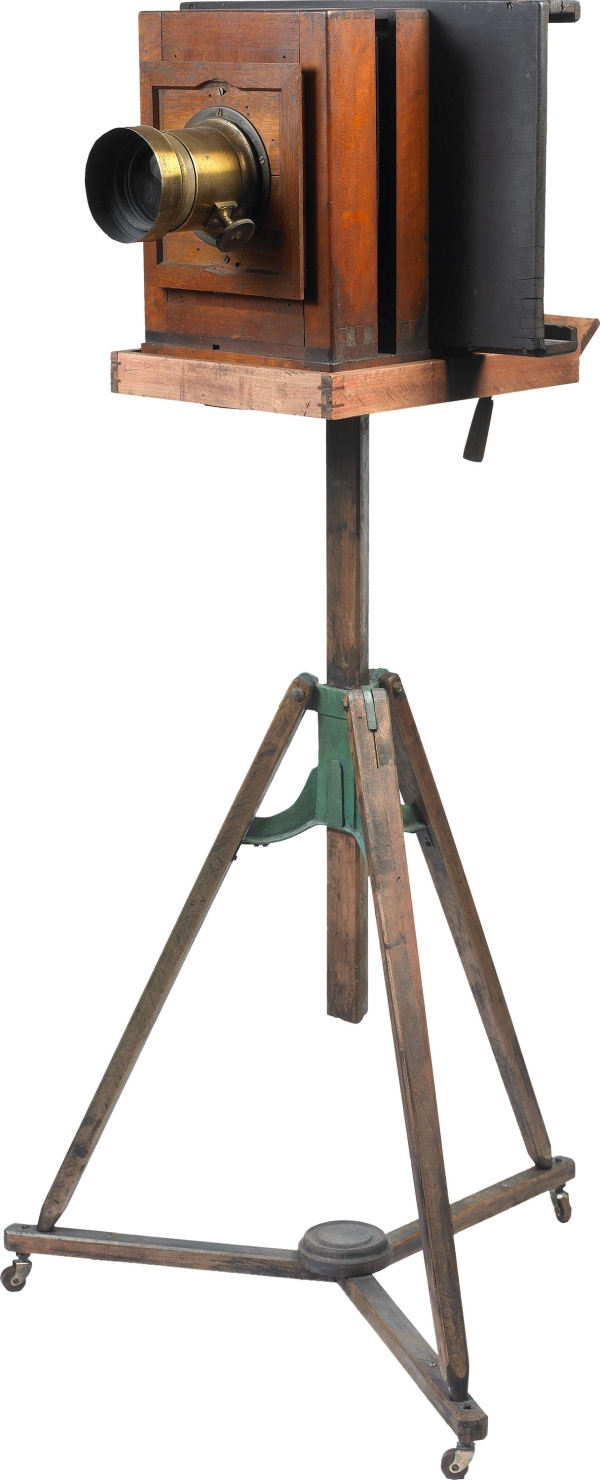
Historic Mathew Brady Studio Camera circa early 1860s; Library of Congress, Prints & Photographs Division
You Can’t Say That! offers readers insight into the experiences of thirteen contemporary children’s authors in facing down censorship of their work. The conversations are absorbing, honest, illuminating, and accessible.
Levels and Layers of Learning
Grade level: Grade 6-up
Social-Emotional Learning Themes
Acceptance, compassion, concern, connection, creativity, dedication, diligence, effort, empathy, encouragement, empowerment, friendship, generosity of spirit, gratitude, helpfulness, hope, inspiration, kindness, loyalty, perseverance, persistence, perspective, resilience, resourcefulness, respect, responsible decision-making, relationship building , self-assurance, self-awareness, self-management, self-reliance, social awareness, tenacity, understanding
Content Area Connections: Social Studies, Art
Using This Book in the Classroom
Hit the Ground Running Ready Resources for Educators, Homeschoolers, and Parents
Meet-the-Author recording in which Leonard shares some of the backstory for Mr. Lincoln Sits for His Portrait.
Candlewick Press has generously provided a link to the beginning and first chapter of You Can’t Say That!.
The following articles report recent censorship news:
“Students want new books. Thanks to restrictions, librarians can’t buy them.” Washington Post, January 22, 2023
“Students want new books. Thanks to restrictions, librarians can’t buy them.” Literary Affairs summary of Washington Post article
“Over 1600 Books Were Banned During the Past School Year” Smithsonian Magazine, September 23, 2022
Write Away! Ideas to prompt writing
What is one piece of information you learned from Mr. Lincoln Sits for His Portrait that wowed you? Explain why.
Mathew Brady’s portrait of Lincoln from February 1860 (page 25) is one that is thought to show Lincoln “ready to lead.” Do you agree? Why? Explain.
Why do you think the photograph of Lincoln with his son Tad (on the cover of the book) is considered to be an “iconic image” of President Lincoln.
Imagine Lincoln were alive today. What aspects of technology do you think he would be most intrigued by? Explain.
Reflect on one author’s interview in You Can’t Say That!.
Poetry Break Related poetry to recite before or following the reading of this book
Poetry breaks fit perfectly into brief moments in the school day—from opening or closing exercises to lining up for lunch; from zipping up backpacks and jackets to transitioning from one subject to the next. Reading a poem typically takes less than a minute; yet, it can introduce or reinforce a concept, provide clarity, celebrate language, exemplify rhythm, enhance vocabulary, expand understanding of a concept, increase attention span, initiate reflection, spark imagination, or simply summon a giggle. And, poetry soothes and strengthens the spirit.
The following poetry book celebrates our sixteenth President :
- The Superlative A. Lincoln: Poems About Our 16th President by Eileen R. Meyer, illustrated by Dave Szalay
And Then There’s This…
Enrichment activities, related books, online resources, craft projects, and ideas for further study
In November 2022, the SCBWI Impact and Legacy Fund partnered with the National Coalition Against Censorship to host a discussion: Are You Free to Read What You Want?.Hear directly from children’s and young adult authors Lesléa Newman (interviewed by Leonard in You Can’t Say That!) , Mike Curato, and Ellen Hopkins discuss the impact of book banning on education and freedom of speech with high school student leaders.
EveryLibrary is a gold-rated nonprofit that supports public and school libraries and offers resources related to community advocacy in regards to censorship, legislation, misinformation, and more.
Developed by EveryLibrary, Fight for the First provides information and resources to help communities fight book banning efforts on a local level.
“Was Abraham Lincoln a Social Media Influencer?” NYT Sunday Book Review, 1/8/23
Smithsonian National Portrait Gallery portrait of Lincoln
Getty Images of Abraham Lincoln
“Four Questions for Leonard S. Marcus” Publisher’s Weekly, December 13, 2022
Extension Activity: Choose one aspect of Lincoln’s life touched upon in Mr. Lincoln Sits for His Portrait and learn more by reading about it in another biography of Lincoln or another reliable source. For instance, learn more about Grace Bedell, the eleven-year-old girl who wrote to Lincoln suggesting that he grow a beard (pp. 29-32). See the list of Related Books of Interest for possible sources.
Related Books of Interest:
The following books explore aspects of Lincoln’s life and accomplishments.
- Abe Lincoln at Last! Magic Tree House #47 by Mary Pope Osborne, illustrated by Sal Murdocca
- Abe Lincoln at Last! Magic Tree House Fact Tracker by Mary Pope Osborne and Natalie Pope Boyce, illustrated by Sal Murdocca
- Abe Lincoln Crosses A Creek: A Tall, Thin Tale by Deborah Hopkinson, illustrated by John Hendrix
- Abe Lincoln: His Wit and Wisdom from A-Z by Alan Schroeder, illustrated by John O’Brien
- Abe’s Honest Words: The Life of Abraham Lincoln by Doreen Rappaport, illustrated by Kadir Nelson
- Abraham by Frank Keating, illustrated by Mike Wimmer
- Abraham Lincoln by Amy L. Cohn and Suzy Schmidt, illustrated by David A. Johnson
- Abraham Lincoln Comes Home by Robert Burleigh, illustrated by Wendell Minor
- Dancing Hands: How Teresa Carreño Played the Piano for President Lincoln by Margarita Engle, illustrated by Rafael López
- He Has Shot the President! by Don Brown
- Honey, The Dog Who Saved Lincoln by Shari Swanson, illustrated by Chuck Groenink
- Lincoln and Douglass: An American Friendship by Nikki Giovanni, illustrated by Bryan Collier
- Lincoln and Grace: Why Abraham Lincoln Grew a Beard by Steve Metzger, illustrated by Ann Kronheimer
- Lincoln and His Boys by Rosemary Wells, illustrated by P. J. Lynch
- Lincoln Clears A Path: Abraham Lincoln’s Agricultural Legacy by Peggy Thomas, illustrated by Stacy Innerst (Click here for the Children’s Book Corner blog post on this book.)
- Lincoln Tells a Joke: How Laughter Saved the President (And the Country) by Kathleen Krull and Paul Brewer, illustrated by Stacy Innerst
- Long, Tall Lincoln I Can Read! 2, by Jennifer Dussling, illustrated by Chin Ko
- Looking at Lincoln by Maira Kalman
- Mr. Lincoln’s Boys: Being the Mostly True Adventures of Abraham Lincoln’s Trouble-Making Sons, Tad and Willie by Staton Rabin, illustrated by Bagram Ibatoulline
- Our Abe Lincoln by Jim Aylesworth, illustrated by Barbara McClintock
- Vinnie and Abraham by Dawn FitzGerald, illustrated by Catherine Stock
- For older readers:
- Abraham Lincoln & Frederick Douglass: The Story Behind An American Friendship by Russell Freedman
- Abraham Lincoln The Writer: A Treasury of His Greatest Speeches and Letters, compiled and edited by Harold Holzer
- Father Abraham: Lincoln and His Sons by Harold Holzer
- History’s All-Stars: Abraham Lincoln by Augusta Stevenson, illustrated by Jerry Robinson
- Lincoln: A Photobiography by Russell Freedman (Newbery Award)
- Lincoln through the Lens: How Photography Revealed and Shaped an Extraordinary Life by Martin W. Sandler
- The Lincolns: A Scrapbook Look at Abraham and Mary by Candace Fleming
- The President is Shot! The Assassination of Abraham Lincoln by Harold Holzer
Find a unit on Abraham Lincoln in The Read-Aloud Scaffold: Best Books to Enhance Content Area Curriculum, Grades Pre-K-3 by Judy Bradbury; pp.122-125.
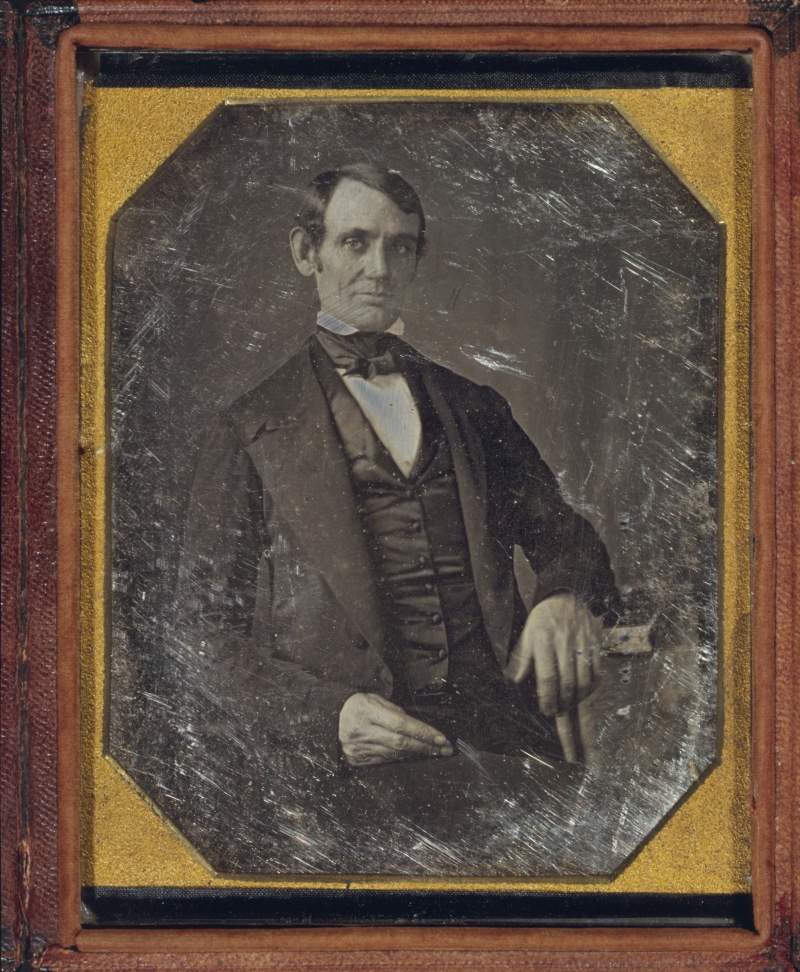
Library of Congress, Prints & Photographs Division, Daguerrotypes Collection
Meet the Author
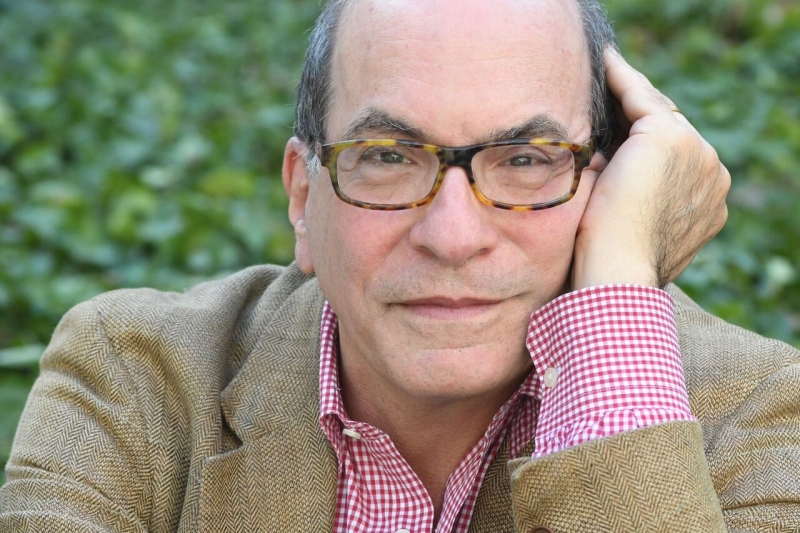
Photo credit: Sonya Sones
Leonard S. Marcus
Leonard S.Marcus is one of the world’s leading writers about children’s books and the people who create them. He is the author of more than 25 critically acclaimed books including Margaret Wise Brown: Awakened by the Moon; Dear Genius: The Letters of Ursula Nordstrom; You Can’t Say That!:Writers for Young People Talk about Censorship, Free Expression, and the Stories They Have to Tell; and Pictured Worlds, an international history of the illustrated children’s book.
Leonard is a frequent contributor to the New York Times Book Review and has been a commentator on radio and television. He is a founding trustee of the Eric Carle Museum of Picture Book Art and was the curator of the New York Public Library’s landmark exhibition, The ABC of It: Why Children’s Books Matter. He is currently curating an exhibition on the idea of home in children’s literature at the National Building Museum.
Leonard received an honorary doctorate of humane letters from the Bank Street College of Education in 2007 and is the only American to have won China’s Chen Bochui Award for special contributions to the development of Chinese children’s literature. Leonard lives in Brooklyn, NY, and lectures about his work across the world. Learn more on Leonard’s website.
Backstory: Q & A with Leonard S. Marcus
I have been a fan of Leonard’s books since reading Dear Genius: The Letters of Ursula Nordstrom years ago when I was fairly new to writing for children. I have since read a shelf-full of his books and have had the opportunity to hear him speak, and I have yet to be disappointed with the care and depth of information he offers on any given subject. I am pleased to introduce Leonard to you here at the Children’s Book Corner. I know you will find him to be as knowledgeable and interesting as I have. I am also looking forward to welcoming Leonard to the Niagara Frontier Reading Council’s discussion of You Can’t Say That! in March. Learn more about that virtual event and how you can attend in the “News, Updates, and Items of Interest” section below.
Judy Bradbury: You Can’t Say That! Writers for Young People Talk About Censorship, Free Expression, and the Stories They Have to Tell offers readers insight into the experiences of thirteen contemporary children’s authors in facing down censorship of their work. The conversations are absorbing: honest and illuminating. Why did you decide to write this book and how did you choose who to spotlight?
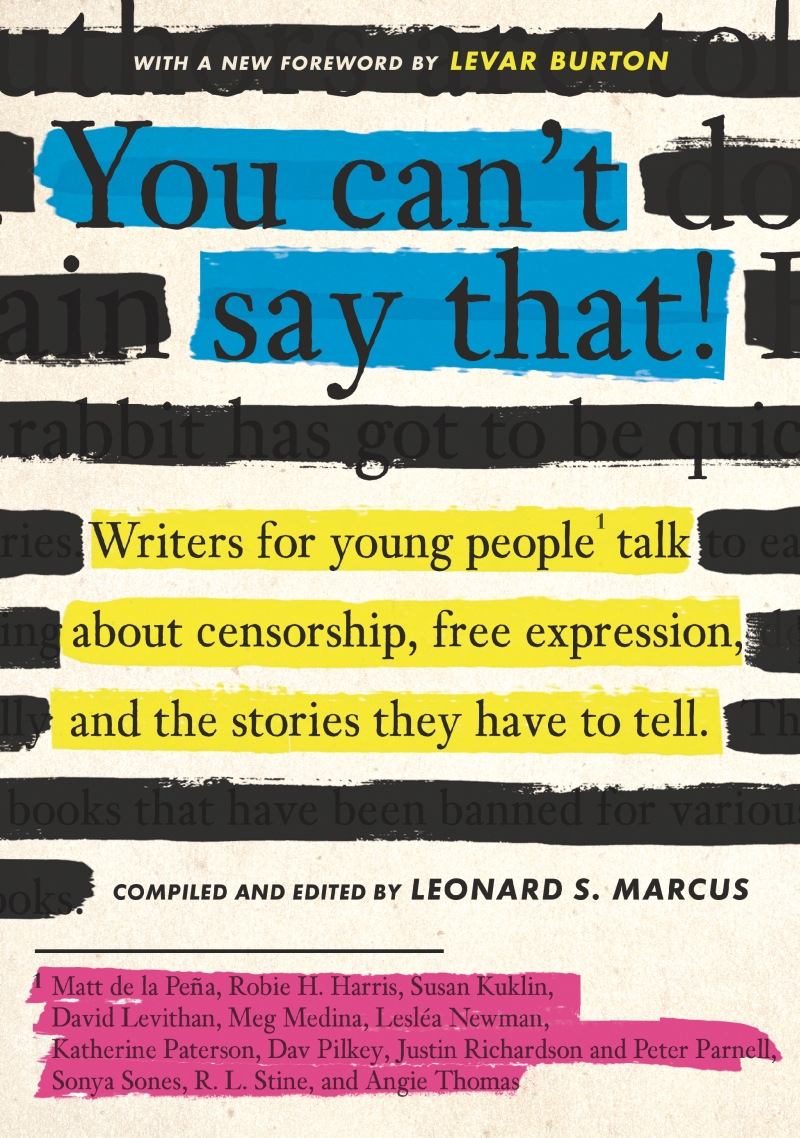
Leonard S. Marcus: I was aware that censorship was on the rise in the US and I found that development deeply disturbing. In 2015 and 2016, I was asked to speak about the history of censorship at children’s literature conferences at UC Fresno and the Bank Street College of Education, and it was after those two experiences that I began to form the plan for my book. Several of the authors I interviewed for You Can’t Say That! were participants in one or both conferences. I found their accounts of their on-the-ground encounters with censorship both moving and revelatory. These were stories, I felt, that needed to be shared.
JB: Can you point to one or two anecdotes in the book that were especially impactful to you?
LSM: Well, there are many. Robie H. Harris, author of It’s Perfectly Normal, spoke about a public librarian who told her she would not purchase her books for her own family but nonetheless felt it was her responsibility to make such well-regarded books available to the public she served, so that everyone could make their own choice. That is how the system is supposed to work! Lesléa Newman, author of Heather Has Two Mommies, described many instances of being harassed and verbally attacked for her work, but she also recalled a man who came to hear one of her talks who said publicly that she had changed his mind about the value of making a book like Heather available to young people. What we need is more conversation and thoughtful listening and less ranting from an ideologically driven, uninformed point of view.
JB: What was your first experience with censorship?
LSM: I grew up in Mount Vernon, New York, not far from where the colonial-era printer John Peter Zenger got into trouble for calling out the corrupt practices of the colonial governor of New York. The resulting trial, in which it was decided that Zenger had not libeled the governor because what he printed about him was true, inspired the drafters of our First Amendment and its protection of freedom of the press. Zenger was a kind of local hero to the teachers in my public elementary school, so we always heard about him in history class. But I first became more aware of censorship as an ongoing issue when I edited Harper publisher Ursula Nordstrom’s letters, and realized how many of the books she published–children’s books by Maurice Sendak and others–came under attack in our time. As I learned and wrote more about the recent history of American children’s books, the instances of censorship I was aware of multiplied: Judy Blume, Madeleine L’Engle…the list goes on and on.
JB: What are the ramifications when freedom of expression is threatened?
LSM: Our life as a society is diminished. A chilling atmosphere results which makes authors, illustrators, publishers, booksellers, and others less likely to do something daring or innovative.
JB: You are widely known as an expert in children’s literature and are a highly-regarded historian in the field. Share your thoughts on the history of censorship and why you think children’s literature is today’s most frequently challenged category of books.
LSM: We have had censorship of one kind or another throughout our history, but it has never been as well organized as now. The current version is part of a much more broadly based trend, the oft-noted polarization of our society, and politicians have found many opportunities lately to attack books on an us-against-them basis. In general, I think censorship occurs when parents become afraid of losing control over their children’s education, especially their moral education. We seem to have less faith now than at other times that institutions such as the public schools and public libraries around the country have their communities’ best interests at heart. We are supposed to be a pluralistic, live-and-let-live society, but there seems to be a significant number of people now who don’t share that vision of America, and have decided instead to hunker down with their own beliefs about everything.
JB: Mr. Lincoln Sits for His Portrait: The Story of a Photograph That Became an American Icon is an unusual biography in that it weaves detailed information about advances in photography in Abraham Lincoln’s time into the story of his rise to President. Along the way, you profile photographers who helped Lincoln shape his image. And the events are not laid out chronologically. Tell us about this project: how you became interested in writing a biography of Abraham Lincoln for middle grade readers (and up) that explores photography advancements in Lincoln’s time and his shrewd use of technology to improve his image among the American people, and how you decided on the structure of the book.
LSM: As a child, I read almost nothing but biographies, and Lincoln was one of my heroes. In fifth grade, I wrote a long fact-based story about him for the “long project” we were asked to do. In a sense, in writing Mr. Lincoln, I was writing the kind of book I grew up on as a young reader.
Cradle-to-grave biographies certainly have their place, but the outlines of Lincoln’s life are so well known that I thought it would be more interesting to try a different approach. I have long kept a postcard of the well-known photo of Lincoln reading to his son Tad by my desk, and it occurred to me one day that that photo might have a fascinating backstory. Posing that question gave me a focused goal for research and it led in many surprising directions. I was surprised, for instance, to learn that in the middle of the Civil War, Lincoln had invited a painter to work in the White House for several months, to produce a monumental history painting inspired by the Emancipation Proclamation.
Lincoln enjoyed the company of artists, and for me this discovery highlighted the fact that Lincoln was himself a kind of artist: a visionary who not only wrote eloquently but who also understood how to lead the public in bold new ways, through the use of images and symbols. Photography–a relatively new invention in 1860–became an important tool for him in this effort. Lincoln’s critics loved to say he was an unpolished and homely man–that he looked like a baboon! But through the dozens of photos Lincoln sat for as a candidate and president he was able to show the world that he was in fact a strong, compassionate, and even fatherly human being. Immediately after his assassination, the portrait of Lincoln reading to Tad, which was originally taken as a reference photo for the painter I mentioned, became a powerful symbol of Lincoln as the patient, caring father of the nation. It did as much as anything to fix the image of Lincoln that we all still carry around with us in our hearts and minds.
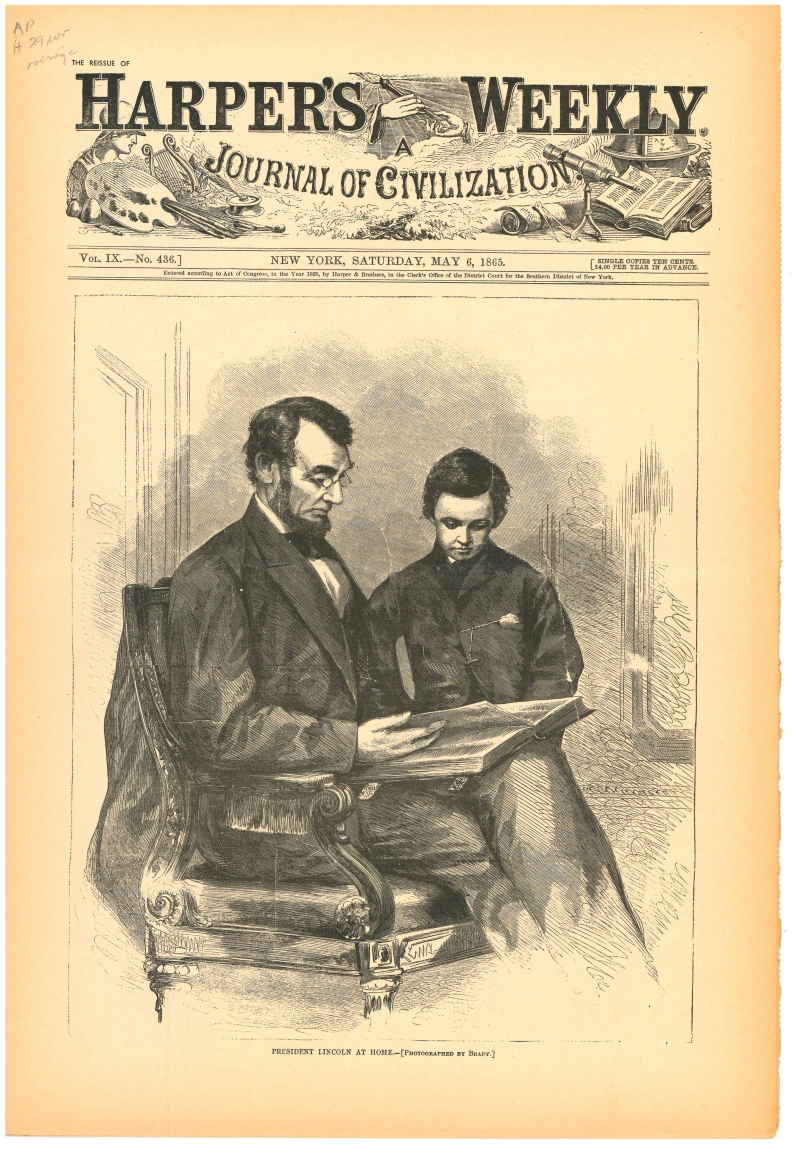
Harper’s Weekly cover illustration, May 6, 1865; courtesy of Abraham Lincoln Presidential Library and Museum
Lincoln’s interest in photography also illustrated another little-known aspect of his life–and particular genius. He loved new technologies, making brilliant use of the telegraph (another mid-nineteenth century wonder) to direct the war from the White House and to get his speeches out to the entire country. And he saw that the railroads would ultimately bind the nation back together and fought successfully for the construction of the transcontinental railroad. Lincoln was an early adopter!–and we can only imagine what funny, smart things he would have had to say on Twitter.
JB: Tell about one hurdle you experienced in the creation of Mr. Lincoln Sits for His Portrait: The Story of a Photograph That Became an American Icon, or provide a memorable (or humorous!) anecdote related to the writing of the book.
LSM: As part of my story, I wanted to recreate the day–-February 9, 1864–during which the Lincoln and Tad photograph was taken. My goal was to show him at ground level, almost as if we were hanging out with him for that one day and seeing what he was really like as president. This took a lot of doing, but I eventually found letters and memoirs of the people close to him that filled in the story in a way that came to feel vivid to me.
As part of this quest, I wanted to know everything there was to know about the making of the photo of Lincoln and Tad. One question that came up was: what book was Lincoln reading? Many people–including a cataloguer at the Library of Congress–have been convinced it was a bible. In reality, it was something quite different: a sample catalog that the photo studio kept on hand to advertise its wares. The catalog made a good prop for the photo and Lincoln, who put on his reading glasses for the first and only time in a photo, had played along, as had Tad, who was famous for not standing still for long for anything. I love that the photo is a piece of theater that gives us a glimpse of Lincoln’s mischievous side. It is also the most intimate photo of Lincoln by far. The Lincoln I “met” is someone I would have loved to know.
JB: What would surprise readers to learn about you or about the writing of Mr. Lincoln Sits for His Portrait?
LSM: It might surprise people to know that as a young child I was what was then called a “remedial reader.” I was very verbal but I struggled to learn to read. Lincoln’s son Tad had much more serious learning difficulties. The ten-year-old we see in the photo had still not learned to read. This gives an added poignancy to the knowledge that Lincoln often read to his sons at night–when he wasn’t reciting Shakespeare by heart for them.
JB: What do you hope young readers will take away from Mr. Lincoln Sits for His Portrait?
LSM: I hope I was able to create a portrait of Lincoln as a human being that you or I could imagine knowing. Also, I wanted to show that creativity–artistry–is an aspect of leadership. When Lincoln arrived in Washington, the Capitol dome was only half-built. He insisted on completing it as quickly as possible–a huge and costly task. When accused by critics of choosing a frivolous priority, Lincoln replied that nothing was more important at a time when the country seemed to be unraveling than to show the world that his government could finish whatever it started.
JB: How do you see Mr. Lincoln Sits for His Portrait connecting to curriculum or being used in schools?
LSM: Lincoln’s contributions to the making of a “more perfect union” through his leadership in the drive to abolish slavery is well known. I think my book gives added insight into the way he went about accomplishing that historic goal. When a historical figure is humanized, he or she becomes easier to identify with–and to be inspired by. No one in American history did more with less formal education than Lincoln did. And I think young people will find it “cool” as well as surprising that Lincoln was such a techno nerd as well as such a decent and down-to-earth human being.
JB: Tell us about your other new release, Pictured Worlds: Masterpieces of Children’s Book Art by 101 Essential Illustrators from Around the World.
LSM: Pictured Worlds was inspired by my many visits to the annual Bologna Children’s Book Fair, where children’s books from around the world are exhibited and discussed. It was eye-opening to realize that something like seventy percent of all children’s books never make it to the US. As big as the US publishing industry seems, it is only a fraction of the whole. That realization led me to reflect on cultural differences and how they are expressed in books for young people, both in words and pictures, and why some books travel well across cultural borders and others don’t. Pictured Worlds was many years in the making and it is my attempt to reflect on the key developments that have defined children’s books across the world over the last two-plus centuries. There are over 500 illustrations and dozens of artist profiles and highlighted books, and I hope readers will come away feeling their understanding of the literature and its scope has been substantially broadened.
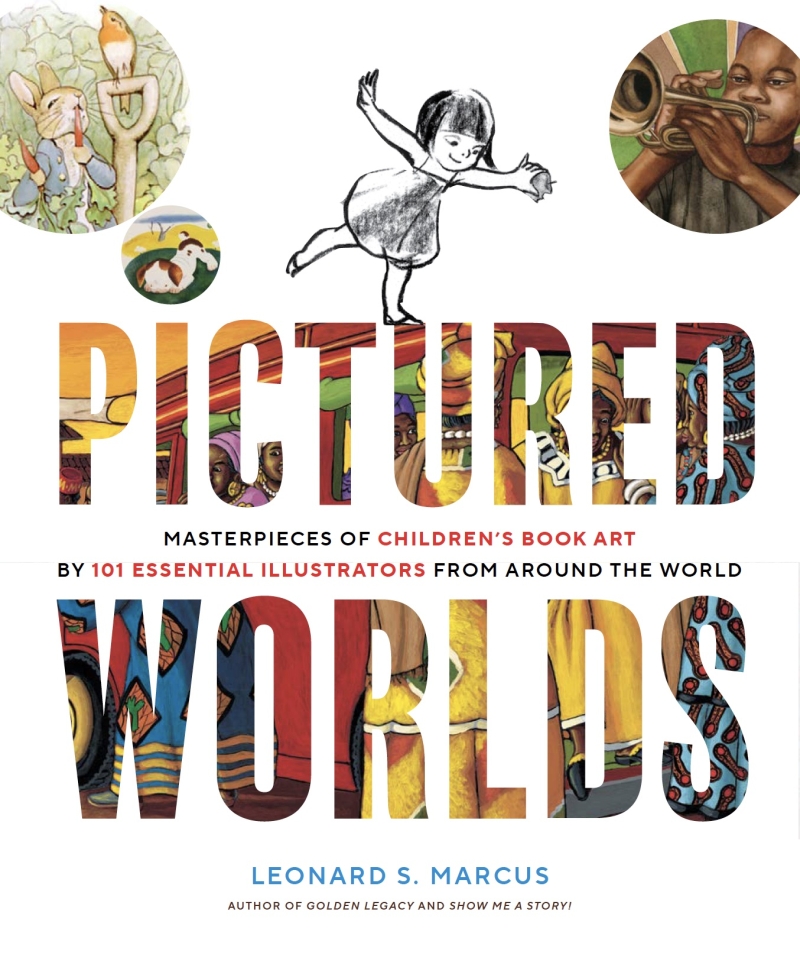
JB: What project are you currently working on?
LSM: I am currently curating three exhibitions all of which will open in the fall of 2023. At the Eric Carle Museum (Amherst, MA), we’ll have “Kid in a Candy Store: The Picture Book Art of Seymour Chwast.” At the Norman Rockwell Museum (Stockbridge, MA) will be “Between Worlds: The Art and Design of Leo Lionni.” And at the National Building Museum in Washington, DC, “Building Stories”—an exhibition about the idea of home in children’s literature. The DC show will remain on view for ten years! I hope lots of people will come and see all three.
Sidebar Spotlight New releases of note
Each month I receive several boxes of books to review from various publishers. As I read and peruse the books, I place them in two piles: those that I will consider featuring on the blog, and those that don’t fit the mission or theme of Children’s Book Corner blog for whatever reason. I highlight some of the books in the “possible” pile on Mondays (most weeks) on Instagram. Ultimately, I choose the one new release I will feature on my monthly blog post. Yet there are many terrific books I wish I could give a shout-out to, even if I can’t write an entire post about each one. So, Sidebar Spotlight is a means of giving a nod to new releases that, in my opinion, are noteworthy. I’ve linked each title to Bookshop so you can learn more. Happy reading, friends! And feel free to comment on these books below.
Patchwork by Matt de la Peña, illustrated by Corinna Luyken; a reflective, lyrical tribute to our differences and our possibilities, and how these make us who we are and who we become as we grow. Highly recommended.
Together with You by Patricia Toht, illustrated by Jarvis; through the seasons a grandmother and her grandson explore their surroundings, but above all they enjoy each other’s company. Sweet, warm, feel-good illustrations accompany the simple rhyming text.
Wild Blue by Dashka Slater, illustrated by Laura Hughes; a delightful, kid-centered picture book that celebrates the milestone of moving up to a big kid’s bike—a wild bike—that a likable kid who is up to the challenge embraces. Think wild horses and you get the idea. Pitch-perfect, enjoyable read-aloud from title page to satisfying conclusion.
News, Updates, & Items of Interest
It’s School Visit season, and I have been enjoying spending time with children who are curious about my characters and excited about reading and writing. Contact me for school visit information.
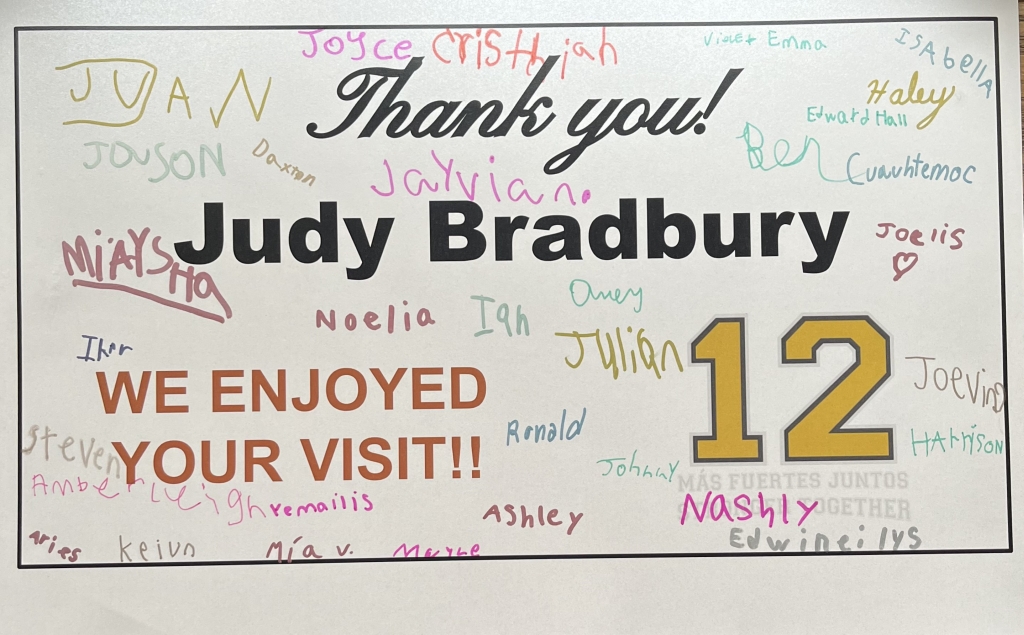
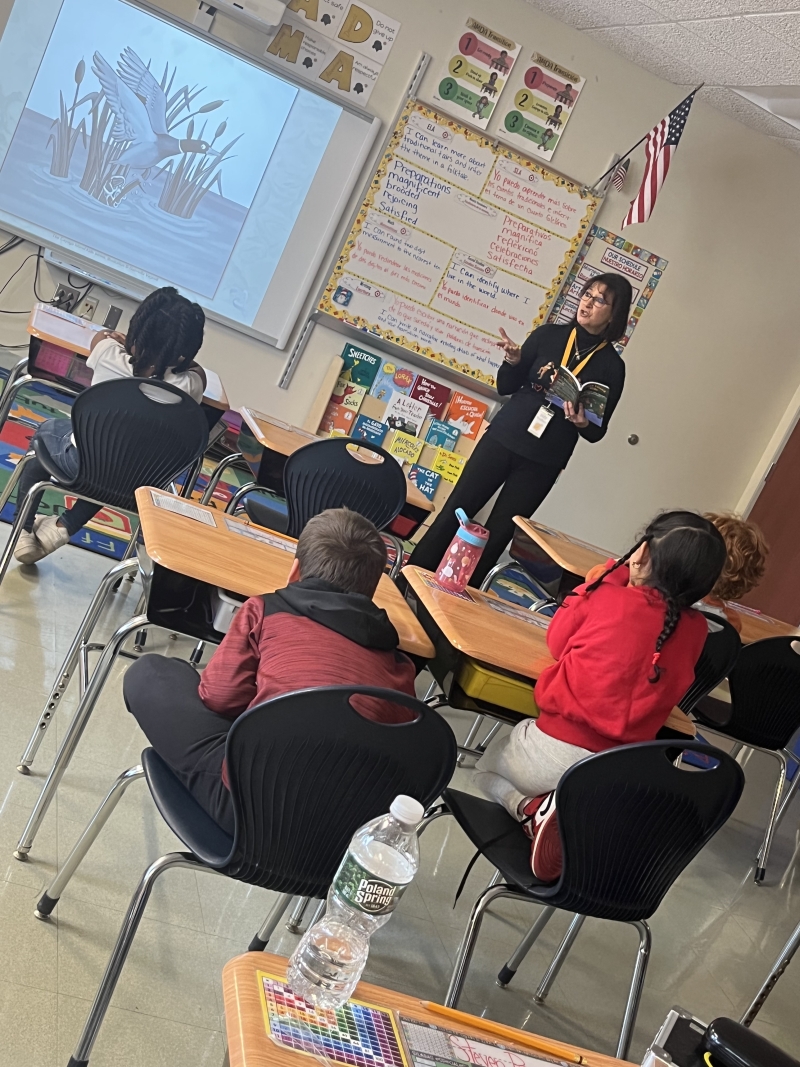
Read-aloud of a portion of Cayuga Island Kids Book 2, The Adventure of the Big Fish by the Small Creek
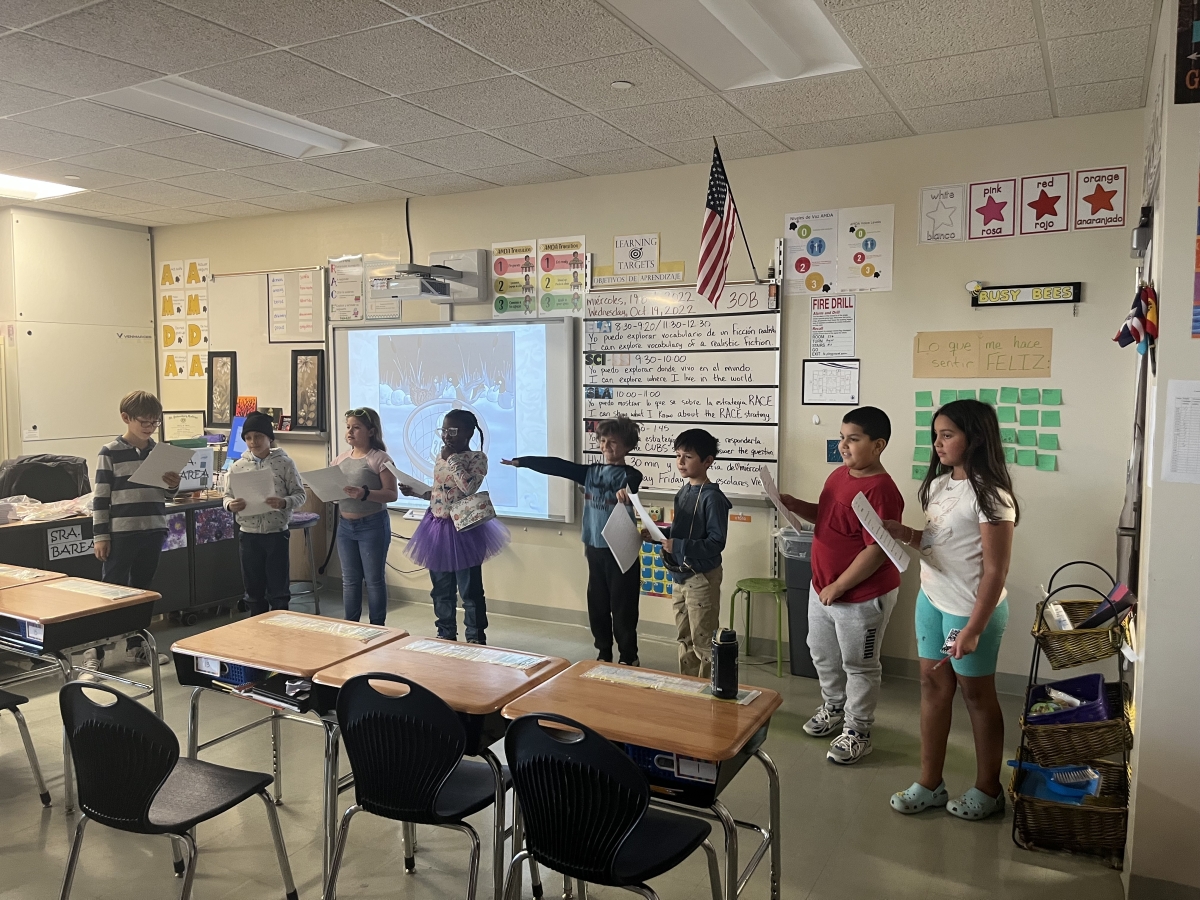
Readers Theater of an excerpt of The Adventure of the Big Fish by the Small Creek, complete with props!
Find where I’ll be appearing with my books on my Events page.
If you read and like a book, consider posting a review on GoodReads or on Amazon (if you bought it there). Authors and illustrators appreciate the shout-out. It increases visibility of their books. Also consider asking your local library to purchase a copy!
The Children’s Book Council together with Every Child a Reader, an award-winning, nonprofit organization whose mission is to celebrate “the powerful impact books have on young people,” is offering ten new Get Caught Reading posters and they are FREE! New posters feature Brad Wagnon, Rosey Alvero, Patricia Cutright, Allan Wolf, Michael Larter, Jon Scieszka, Micheal Anderson, Jordyn Cho, and Casper ter Kuile, and Yoda posters are currently back in stock. Print out the order form for FREE copies.
On January 30, the American Library Association announced the 2023 winners of the coveted Youth Media Awards, including the Newbery, Caldecott, Printz, Coretta Scott King, Pura Belpré, Robert F. Sibert, and more.
Also recently released is the USBBY’s 2023 List of Outstanding International Books.
Check out the Random Acts of Kindness Foundation whose slogan is “Make kindness the norm.” for a wide variety of materials for home, school, and workplace.
The Niagara Frontier Reading Council is hosting a two-evening virtual event on the topic of censorship of children’s books on March 7 and March 21 from 6:00-7:30pm. The first evening will consist of a discussion of the book You Can’t Say That! Writers for Young People Talk About Censorship, Free Expression, and the Stories They Have to Tell compiled and edited by Leonard S. Marcus; on the second evening, Leonard will offer a visual presentation. Find more information here, and click to register here. NFRC and NYSRA members attend free. If you live outside New York State but would like to attend, and you are a subscriber to this blog, contact me for a special code to receive a discount to attend this virtual event.
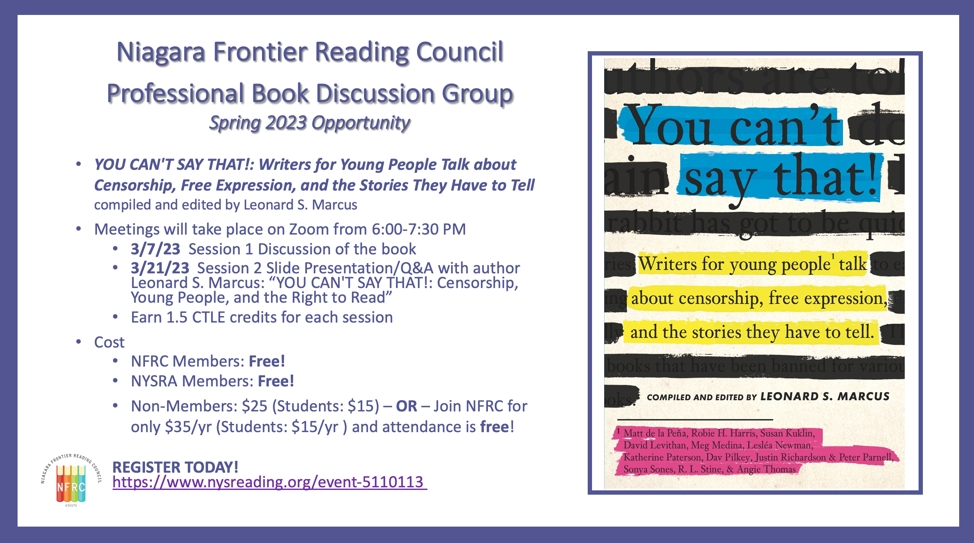
Over to You…
Join the conversation! Offer your thoughts on the featured question related to this month’s post:
Share an experience you have had with censorship.
You are also welcome to post a general comment.
From last month’s post: The winner of a copy of Mr. McCloskey’s Marvelous Mallards, courtesy of Calkins Creek/Astra Books for Young Readers, is Carol Peszko! Congratualtions, Carol! Contact me with your mailing address and I’ll send the book off to you!
Thanks for sharing!
Final Thought
“Censorship reflects a society’s lack of confidence in itself…A book worthless to me may convey some value to my neighbor. In the free society to which our Constitution has committed us, it is for each to choose for himself.” ~ Supreme Court Justice Potter Stewart

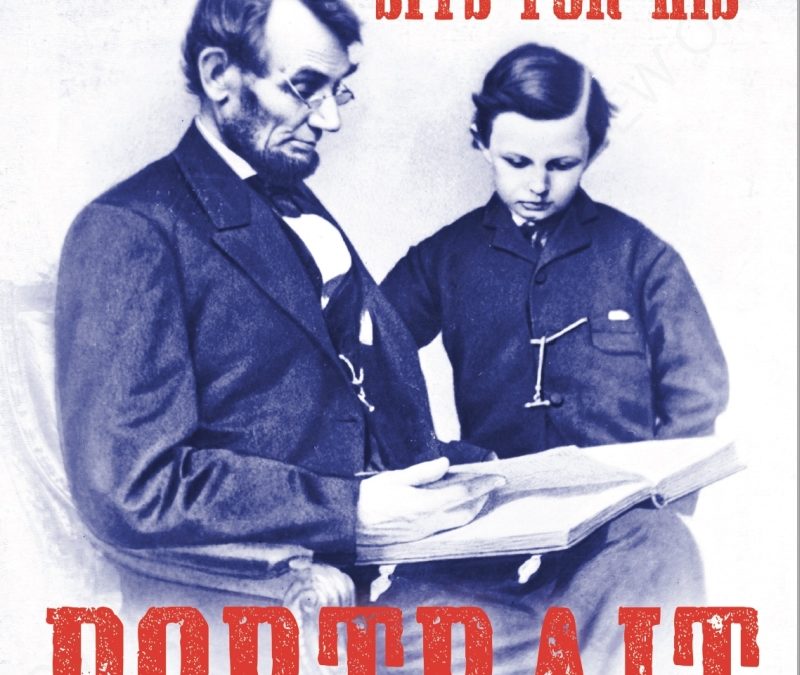
Fascinating interview! I think it says something about the depth and wisdom of President Lincoln that talented writers like Leonard S. Marcus can still find a fresh story that reveals even more about our country’s greatest President. I look forward to reading this book, and I also appreciate the additional insight the author shares about the worrisome trend in our country to ban books. My thanks to Leonard S. Marcus for his many contributions to children’s literature and to Judy Bradbury for shining a light on worthy books and authors of note.
Thanks for your kind comments, Marsha! I couldn’t agree more with yours assessment of Leonard’s contributions to the realm of children’s literature. It is my pleasure to feature him and his books here on Children’s Book Corner.
At first I thought: Why did Judy pick two books? But I loved hearing about both of them and would never have been able to choose between them. Leonard Marcus is a fascinating man, very thoughtful and articulate.
Vivian, I absolutely agree about how fascinating, thoughtful, and articulate Leonard is. Initially, I planned to interview Leonard and highlight YOU CAN’T SAY THAT! as he will be the featured speaker at the upcoming Niagara Frontier Reading Council’s virtual Spring event exploring censorship of children’s books (Open to all! See details above.). But when I learned that Leonard had just published a biography of Lincoln, and knowing that Lincoln was an advocate for freedoms of all kinds, I decided to delve into both books. Heavy lifting, but a worthy endeavor! Thanks for your comment.